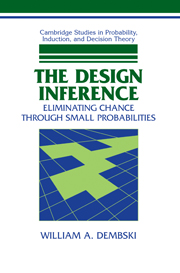Summary
PATTERNS
Our aim remains to explicate and justify the Law of Small Probability. With the theoretical underpinnings for this law now in place (i.e., probability theory and complexity theory), our next task is to explicate the dual notions of specification and small probability. We treat specification in this chapter, small probability in the next. Specifications are those patterns that in combination with small probability warrant the elimination of chance. In explicating specification, we therefore need first to be clear what we mean by a pattern.
By a pattern we shall mean any description that corresponds uniquely to some prescribed event. Formally, a pattern may be defined as a description–correspondence pair 〈D, *〉 where the description D belongs to a descriptive language D and the correspondence * is a partial function between D and a collection of events E so that * includes D in its domain of definition (as a partial function * need not be defined on all of D). 〈D, *〉 is therefore a pattern relative to the descriptive language D and the collection of events E. Formally, D can be any nonempty set, and E any collection of actual or possible events. What makes D “descriptive” is that the correspondence * maps descriptions to events. Since for any pattern 〈D, *〉 the correspondence * includes D in its domain of definition, we let D* denote the event that corresponds to D under *.
- Type
- Chapter
- Information
- The Design InferenceEliminating Chance through Small Probabilities, pp. 136 - 174Publisher: Cambridge University PressPrint publication year: 1998



